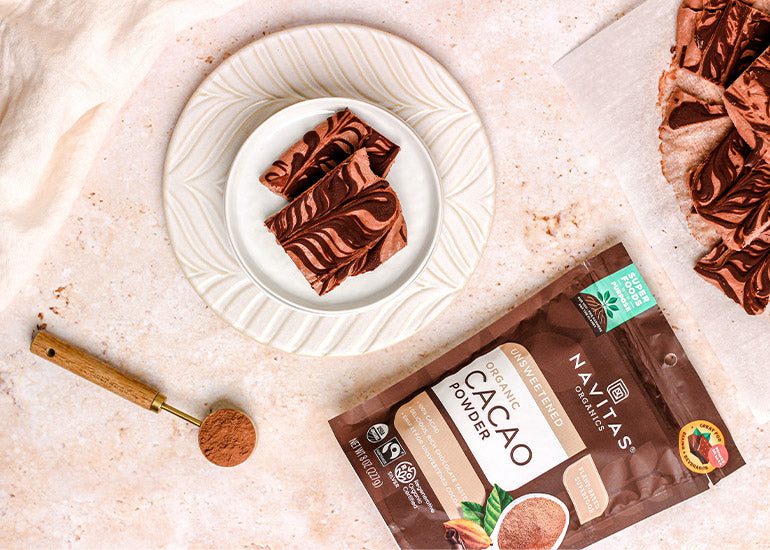The Food of the Gods offers a bounty of health benefits. Find out how a daily fix of cacao can benefit your heart and more, and learn about the best types to use.
Forrest Gump famously stated, “Life is like a box of chocolates; you never know what you’re going to get.” Well, scientific studies have shown that with chocolate, at least types that contain plenty of cacao, you in fact get a food with some serious health creed.
A large study, published in May 2021 in The American Journal of Clinical Nutrition, analyzed data from more than 188,000 veterans and concluded that regularly consuming about 1 ounce of chocolate was associated with a lower risk of coronary artery disease. Further, a meta-analysis published in the journal Nutrients found that chocolate was likely beneficial in reducing the risk of heart disease, stroke, and type 2 diabetes. And a 2023 investigation in the Journal of the Academy of Nutrition and Dietetics showed that eating chocolate just 1 to 3 times a week could help lower the risk of disease-related mortality. Studies also show that consuming dark chocolate with high percentages of cacao may benefit brain functioning including memory (I knew there was a reason I always remember to eat my daily cacao!). Scientists believe it’s the abundance of flavanols in cacao, which are plant chemicals that act as antioxidants to reduce oxidative stress in the body, which are largely to thank for heart health and other benefits. For instance, these flavanols may help improve blood pressure numbers and vascular blood flow which is important in maintaining better heart functioning.
Not to be overlooked is that cacao contains a range of essential micronutrients including iron, potassium, copper and magnesium, so can contribute to the nutrient quality of our diets. There is also some data to suggest that the fiber in cacao behaves like a prebiotic (not to be confused with a probiotic), and because of this can encourage the growth of beneficial bacteria in the gut for a more robust microbiome and better gut health. And cacao flavanols may even help keep us looking a bit more youthful by improving skin health.
Cacao vs Cocoa: What's the Difference?
Despite the similar phonetics, these are not the same. Chocolate is made from cacao beans—or rather seeds—gleaned from the Theobroma cacao tree. The term “cacao” should be reserved for the beans and ground-up contents of the beans taken from the pod-like fruits of the cacao tree. In contrast, cacao is processed to make “cocoa,” including alkalization (a.k.a. Dutch-processing, which extracts bitterness), and high-heat roasting. This processing can lay waste to flavanols and their healthy properties. Generally, less processed cacao contains more antioxidants.
The Healthiest Types of Cacao
While all of these scientific findings can be exciting (especially for your sweet tooth), it’s important to choose your cacao carefully to maximize the benefits. Sugary candy bars are not longevity food. Here are the types to gravitate towards with Wonka-like exuberance.
1. Chocolate Bars
These are essentially a blend of ground-up cacao bean (referred to as chocolate liquor or cocoa mass), cocoa butter (added to improve creamy mouthfeel) and sugar. The higher the cocoa percentage of a bar the less sugar and generally the larger dose of flavanol antioxidants it will contain—chocolate liquor or cocoa mass are where the antioxidants reside. Your best bet is to choose a bar with 70 percent cacao or higher; bars with lower percentages of cocoa have more fillers including added sugars and fat. Because flavanols inherently have a bitter taste, manufacturers add various amounts of sugar and fat to cover up this natural flavor nuance.
2. Cacao Powder
Cocoa powder is made when the cocoa butter (the fatty part) is pressed out of cocoa beans leaving behind a cakey substance that is then dried and pulverized into a powder. Not only does this remove much of the fatty calories, but it also concentrates the flavor as well as nutrients and antioxidants. Each bag of Navitas Organics Cacao Powder contains only non-alkalized powder for maximum antioxidant firepower. Use it in baking, smoothies, and as an addition to oatmeal for a chocolatey flavor boost.
3. Cacao Nibs
Take whole cacao beans from the cacao tree, crush them into small crunchy bits and you end up with beautifully bittersweet cacao nibs. Think of them as chocolate in its most rudimentary form and Mother Nature’s chocolate chips. Navitas Organics Cacao Nibs, along with Power Snacks like the Chocolate Brownie snack, are especially high in flavanols and fiber. Sprinkle cacao nibs on oatmeal, yogurt, cottage cheese, fruit salads, smoothie bowls, and ice-cream. They’re also a surprisingly great addition to vegetable salads.
4. Cacao Butter
This is essentially the isolated fatty part of the cocoa bean and is used in chocolate bar production to give the treat its to-die-for melt-in-your-mouth quality. You can also source pure cacao butter such as Navitas Organics Cacao Butter Wafers which lends anything it’s added to a delicious creamy texture and chocolate scent. While cacao butter contains a fair amount of saturated fat, the majority of this is in the form of stearic acid which appears to have a more neutral impact on heart health compared to the saturated fat found in meat. Watch out for chocolate products containing cheap vegetable oils instead of cacao butter.
How to Buy the Best Cacao
When possible, select brands like Navitas Organics that bring to market certified organic cacao which assures you the cacao trees were grown sustainably without the use of hazardous chemicals, some of which are banned for use in North America. Further, Fair Trade certification means humanely harvested cacao with farmers being compensated above-market prices allowing for a better quality of life. Chocolate has a long, sad history of slave and child labor, which Fair Trade helps address.
Most of the chocolate sold in stores is made by blending cacao beans from different countries. In a “single-origin” chocolate produce like Navitas Organics Cacao Nibs, all the beans were sourced from one country, perhaps even from a single farm. Like wine, chocolate aficionados believe chocolate has terrior with different growing regions offering different flavor nuisances such as fruity, nutty and smoky.
)

